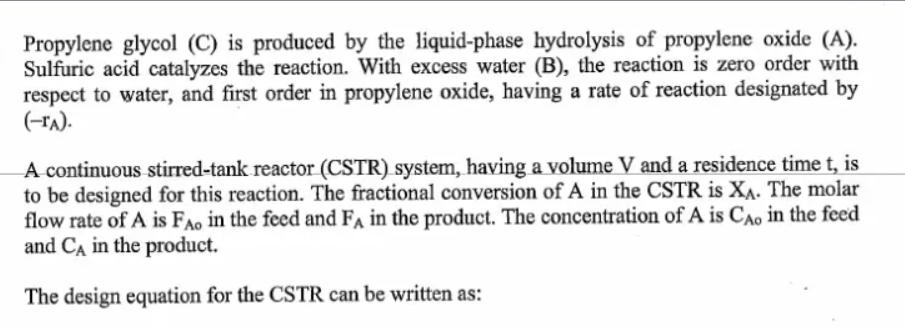Question
Propylene glycol (C) is produced by the liquid-phase hydrolysis of propylene oxide (A). Sulfuric acid catalyzes the reaction. With excess water (B), the reaction

Propylene glycol (C) is produced by the liquid-phase hydrolysis of propylene oxide (A). Sulfuric acid catalyzes the reaction. With excess water (B), the reaction is zero order with respect to water, and first order in propylene oxide, having a rate of reaction designated by (-ra). A continuous stirred-tank reactor (CSTR) system, having a volume V and a residence time t, is to be designed for this reaction. The fractional conversion of A in the CSTR is XA. The molar flow rate of A is FAo in the feed and FA in the product. The concentration of A is CA, in the feed and CA in the product. The design equation for the CSTR can be written as:
Step by Step Solution
There are 3 Steps involved in it
Step: 1

Get Instant Access to Expert-Tailored Solutions
See step-by-step solutions with expert insights and AI powered tools for academic success
Step: 2

Step: 3

Ace Your Homework with AI
Get the answers you need in no time with our AI-driven, step-by-step assistance
Get StartedRecommended Textbook for
Elements Of Chemical Reaction Engineering
Authors: H. Fogler
6th Edition
013548622X, 978-0135486221
Students also viewed these Chemical Engineering questions
Question
Answered: 1 week ago
Question
Answered: 1 week ago
Question
Answered: 1 week ago
Question
Answered: 1 week ago
Question
Answered: 1 week ago
Question
Answered: 1 week ago
Question
Answered: 1 week ago
Question
Answered: 1 week ago
Question
Answered: 1 week ago
Question
Answered: 1 week ago
Question
Answered: 1 week ago
Question
Answered: 1 week ago
Question
Answered: 1 week ago
Question
Answered: 1 week ago
Question
Answered: 1 week ago
Question
Answered: 1 week ago
Question
Answered: 1 week ago
Question
Answered: 1 week ago
Question
Answered: 1 week ago
Question
Answered: 1 week ago
Question
Answered: 1 week ago
Question
Answered: 1 week ago
Question
Answered: 1 week ago
View Answer in SolutionInn App



